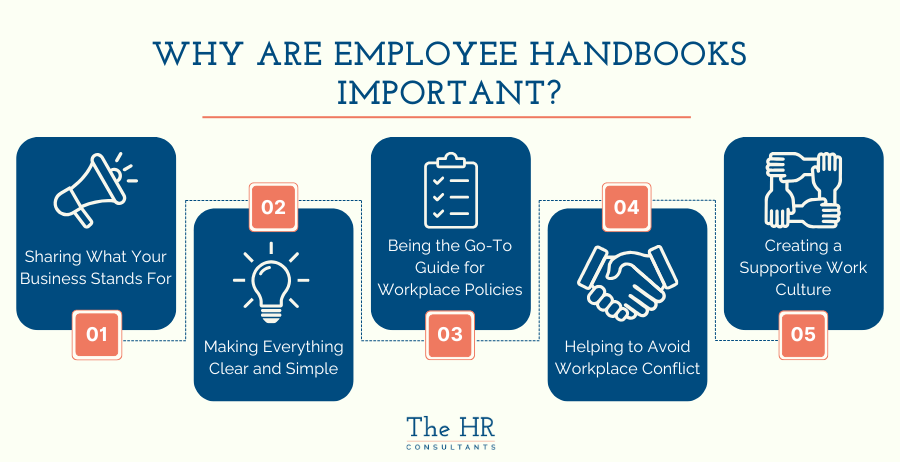"At The HR Consultants, we’ve spent over 20 years helping businesses like yours understand why employee handbooks are important—and we’ve seen first-hand the difference they can make.
Think of an employee handbook as your company’s go-to guide. It sets expectations, keeps everyone on the same page, and helps create a positive work environment.
In this post, we’ll walk you through the benefits a strong employee handbook can bring to your business.

[addCTA blink=""/services/employment-law-services/"" title=""Looking to create or update your employee handbook?""]
What is an Employee Handbook?
An employee handbook is your company’s personalised guidebook—a resource that explains the key policies, procedures, and expectations that shape your workplace. Also known as an employee manual, it's a practical document that provides clarity for both employers and employees, ensuring everyone understands their rights and responsibilities.
Whether it’s answering a quick question or addressing a bigger concern, the handbook is there to support you and your team every step of the way.
What is the Purpose of an Employee Handbook?
An employee handbook acts as a bridge between management and employees. It serves a few key purposes:
- Setting clear expectations: Clear communication supports employee relations—in fact, Forbes highlights that over 40% of workers feel trust in leadership improves with better communication.
- Keeping things consistent: Fairness matters, and a handbook ensures policies are applied equally, avoiding confusion or uneven treatment.
- Safeguarding compliance: It’s also a tool for outlining legal requirements, helping to protect your business while keeping your team informed.

Why Are Employee Handbooks Important?
Now you know the purpose of an employee handbook, let's go through the impact this has on your business.
Sharing What Your Business Stands For
Job satisfaction matters and when employees know the ""why"" behind their work, it creates stronger connections and motivation. In 2020, a McKinsey & Company survey found that 82% of employees feel it’s important for their company to have a clear sense of purpose.
Making Everything Clear and Simple
A good handbook spells out exactly what your employees need to know, including the standards for the employment relationship—whether it’s about performance, behaviour, or day-to-day responsibilities. Clear expectations mean fewer misunderstandings and a smoother workflow.
Being the Go-To Guide for Workplace Policies
From sick leave to social media use, the handbook is a handy guide for all your company policies. Instead of asking around or feeling unsure, employees can quickly find the answers they need, making life easier for everyone.
Helping to Avoid Workplace Conflict
Disagreements happen, but with a clear set of guidelines in place, an employee handbook helps to prevent small issues from turning into big conflicts or creating a negative workplace environment.
Creating a Supportive Work Culture
An employee handbook isn’t just about rules, it’s a reflection of your company culture. It’s your chance to show your team what kind of workplace you want to create—one where they feel valued, respected, and supported every step of the way.

How Employee Handbooks Make Onboarding Easier
Starting a new job can feel overwhelming, but a comprehensive employee handbook acts as a friendly guide to help new hires settle in quickly. It provides clear explanations of your company’s policies, from holiday entitlement to dress codes, giving new employees the confidence to hit the ground running. Instead of worrying about what’s expected of them, they can focus on getting to know the team and embracing their role.
Making the Onboarding Process More Efficient
An employee handbook is like a time-saver for onboarding. Instead of answering the same questions multiple times, managers can point new hires to a comprehensive resource that’s easy to understand. This not only saves time but also ensures that every employee receives the same consistent information.
What Should Be Included in an Employee Handbook?
Let's go through what you should include in your employee handbook and why.
Related: What Makes a Great Employee Handbook?
The Basics Everyone Needs to Know
Let’s start with the essentials—the stuff your employees will refer to all the time. Include key policies and procedures like your code of conduct, attendance rules, and leave policies. For example, let your team know how to book time off, what to do if they’re running late, and what’s expected in terms of behaviour.
Who You Are as a Company
Your handbook is the perfect place to share your company’s story. Talk about your mission, values, and what makes your business unique. Whether it’s a commitment to sustainability, teamwork, or innovation, use this section to connect your team to your vision.
Working Hours and Taking Time Off
Everyone needs to know the ins and outs of their schedule. Be clear about working hours, break times, and how holidays work. Cover things like annual leave, sick days, and any flexible working options. Spell out how to request time off—nobody wants to feel unsure about asking for a day off to recharge.
Pay, Promotions, and Career Opportunities
Explain how salaries are structured, when pay reviews happen, and how bonuses (if you offer them) are handled. If you have a clear process for promotions or career progression, outline it here. It’s your chance to show employees that you’re invested in their future and value their contributions.
Safety Guidlines
Include simple, clear guidance on fire evacuation procedures, accident reporting, and general workplace safety. If your workplace involves specific risks, make sure to address them.
How You Create a Respectful and Inclusive Workplace
This is where you can highlight your commitment to a fair and respectful environment. Outline your anti-discrimination and harassment policies and explain how employees can raise concerns if they need to. By showing you take these issues seriously, you create a sense of trust and security.
Employee Benefits and Perks
Here’s the fun part—showcase everything your team gets for working with you! From pensions and health insurance to wellness programmes or even free coffee, this is your chance to highlight why your company is a great place to work. Make sure to explain how employees can access these benefits.
Appropriate Technology and Social Media Use
We live in a digital world, so having clear guidelines around technology and social media is a must. Explain how employees should use company devices and what’s expected when it comes to professional behaviour online. If personal use of social media during work hours is okay (within reason), let them know.
Disciplinary Actions
Sometimes, things don’t go as planned, and that’s okay—as long as everyone knows how it’s handled. Include a fair and transparent process for disciplinary actions. Whether it’s a warning or more serious consequences, this section shows that you’re committed to resolving issues in a professional and respectful way.
Confirming They’ve Read the Handbook
Last but not least, include a simple way for employees to confirm they’ve read and understood the handbook. A quick signature or digital acknowledgment works just fine. This step makes sure everyone’s on the same page.
Is an Employee Handbook a Legal Requirement?
The short answer is no—an employee handbook isn’t legally required in the UK. However, some of the information typically found in a handbook is required by law, so having one can make life easier for you and your employees.
What Policies Are Legally Required?
There are certain policies that UK law mandates employers to provide in writing. These can be included in an employee handbook to keep everything organised and accessible. Key examples include:
- Health and Safety Policies: Under the Health and Safety at Work Act 1974, every employer must provide clear guidance on keeping the workplace safe.
- Equality and Anti-Discrimination Policies: The Equality Act 2010 makes it a legal requirement to avoid discrimination and foster an inclusive workplace.
Referencing the Handbook in Employment Contracts
If you reference specific sections of your employee handbook in an employment contract, those sections can become legally binding as ‘incorporated terms.’ In other words, those policies carry the same weight as if they were written directly into the contract.
For example, if your handbook includes a clear disciplinary procedure and it’s incorporated into the contract, you’re legally required to follow that process if an issue comes up. This helps ensure fairness for your employees and protects your business by showing you’ve stuck to the agreed terms, which can help avoid legal disputes.

Physical Vs. Digital Handbooks
One of the simplest ways to share your handbook is digitally. At The HR Consultants, we’ve partnered with Breathe, a cloud-based people system that keeps everything in one secure, easy-to-use platform. With Breathe, your team can access the handbook anytime, anywhere. It’s a fantastic way to save time and cut down on paperwork, and we’re here to help you get started with it.
For those who prefer a physical copy, having a few printed handbooks around the workplace can be really helpful. Whether it’s in the staff room or HR office, printed versions are great for quick reference or for handing out during onboarding.
Don’t forget to make the handbook accessible to everyone. Remote workers will need online access, and team members with specific needs may benefit from alternative formats like large print or audio versions.

Tips for Creating an Employee Handbook
Putting together an effective employee handbook might seem like a big task, but it doesn’t have to be overwhelming. With a little planning and the right approach, you can create a resource that’s practical, approachable, and genuinely helpful for your team. Here are some tips to get you started:
Keep It Simple
Your handbook should be easy to read and understand—after all, it’s there to support your team, not confuse them! Avoid complicated jargon or overly formal language. Short sentences, bullet points, and clear headings can make a big difference.
Update As Needed
Beyond annual reviews, make sure to update your handbook whenever something significant changes in your company. For example, if you introduce a new benefit or tweak your remote working policy, reflect that in the handbook straight away.
Get Expert Input
It’s always a good idea to get a second opinion, especially when it comes to employment laws and compliance. Consulting an HR expert or legal professional ensures your handbook covers all the necessary bases. They can help you navigate tricky areas like disciplinary procedures and anti-discrimination policies, giving you peace of mind that everything’s in order.

Partnering with Experts in HR Documentation
At The HR Consultants, we’re an experienced team passionate about making HR simple and stress-free for businesses like yours. Whether you need a brand-new employee handbook or want to improve an existing one, we’re here to help. Here's what you can expect when you work with us:
- Designed Just for You: No generic templates here. We’ll create a handbook that’s fully personalised to your business, ensuring it reflects your unique style and needs.
- We Make It Easy: Writing a handbook can feel like a big job, but we’re here to guide you every step of the way. Our friendly team will make the process simple.
- Stay Ahead on Compliance: Employment laws change all the time, and it can be hard to keep up. That’s where we come in. We’ll make sure your handbook is compliant and keeps your business protected.
- We’re Always Here for You: Whether you need your handbook as a one-off project or prefer ongoing support, we’ve got you covered. You can opt for an affordable HR package that ensures updates, advice, and continued guidance whenever you need it.
What Our Clients Think
Here’s what one of our happy clients had to say about their experience working with The HR Consultants:
"" The HR Consultants were brilliant to work with - they delivered a bank of HR policies and took the time to get to know the company so that the tone and branding was exactly right. It was refreshing to work with people who wanted to create something unique and personal to the business rather than regurgitating off-the-shelf docs."" Lucy Grainger - Finance Manager and Head of People, The Shoots Group
Book Your HR Documentation Consultation

Frequently Asked Questions
Answering your questions is what we’re here for! Below, we’ve answered some of the most common queries we get about employee handbooks.
If we haven't answered your question, feel free to get in touch with our team—we're here to help!
What is the need and importance of a handbook?
An employee handbook is like a roadmap for your workplace. It helps your team understand the rules, policies, and values that keep everything running smoothly. It’s also a great way to set clear expectations, support new hires during onboarding, and ensure consistency across the business. Plus, it protects your company by keeping everything compliant with employment laws.
How do I create an employee handbook?
Creating an employee handbook doesn’t have to be complicated. Start by thinking about what your team needs to know—policies, procedures, and the unique aspects of your company culture. Keep the tone clear and approachable, so it’s easy for everyone to understand. Consulting with HR or legal experts can help ensure your handbook covers all the important bases. Once it’s ready, make sure it’s accessible—whether that’s digitally, in print, or both—and introduce it to your team with a positive, supportive approach.
How often should an employee handbook be updated?
It’s a good idea to review your handbook once a year, but you might need to update it sooner if there are changes to employment laws, company policies, or benefits. Keeping it current shows your team you’re committed to transparency and ensures your business stays compliant."














